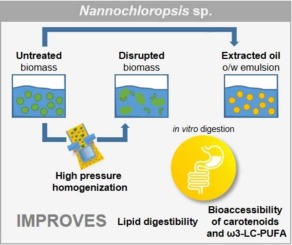Journal of Functional Foods ( IF 3.8 ) Pub Date : 2020-01-03 , DOI: 10.1016/j.jff.2019.103770 Tom M.M. Bernaerts , Heleen Verstreken , Céline Dejonghe , Lore Gheysen , Imogen Foubert , Tara Grauwet , Ann M. Van Loey

|
The incorporation of microalgae into processed food products is considered a sustainable strategy to enrich food products in omega-3 long chain polyunsaturated fatty acids (ω3-LC-PUFA). However, the microstructural properties of the microalgae might influence the nutrient digestibility and bioaccessibility during consumption. The current study proved the importance of cell disruption of Nannochloropsis sp. for the in vitro lipid digestibility and bioaccessibility of ω3-LC-PUFA and carotenoids. While an incomplete lipid digestion and low bioaccessibility values (1–6% for carotenoids and 13% for ω3-LC-PUFA) were observed for untreated biomass, cell disruption by high pressure homogenization resulted in a complete lipid digestibility and a threefold increase in bioaccessibility. It was shown that the Nannochloropsis sp. cell wall and/or cell membrane act as a natural barrier for (lipophilic) nutrients during in vitro digestion. Hence, microalgal cell disruption is a crucial step in the design of healthy food products enriched with microalgae.
中文翻译:

Nannochloropsis sp。的细胞破坏。改善类胡萝卜素和ω3-LC-PUFA的体外生物利用度
将微藻掺入加工食品中被认为是使食品富含omega-3长链多不饱和脂肪酸(ω3-LC-PUFA)的可持续策略。但是,微藻的微结构特性可能会影响食用期间的营养物质消化率和生物利用度。当前的研究证明了破坏Nannochloropsis sp。的细胞的重要性。用于体外ω3-LC-PUFA和类胡萝卜素的脂质消化率和生物可及性。对于未处理的生物质,虽然脂质消化不完整且生物利用度较低(类胡萝卜素为1–6%,ω3-LC-PUFA为13%),但高压均质会破坏细胞,导致脂质充分消化,生物利用度增加三倍。结果表明,Nannochloropsis sp。细胞壁和/或细胞膜在体外消化过程中充当(亲脂性)营养素的天然屏障。因此,微藻细胞的破坏是设计富含微藻的健康食品的关键步骤。











































 京公网安备 11010802027423号
京公网安备 11010802027423号